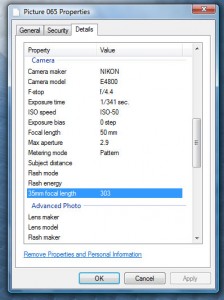EXIF Data
By Walter Hutsky
It seems we are coming to point where we can’t believe in the legitimacy of digital photography and in the paranormal research field this causes some major problems when it comes to credibility. With digital photography and advanced image editing software available to most anyone with a PC, it is easier than ever to forge fake photos. This article describes some ways to help stand your photos up against critics who may claim your photos are not genuine.
Digital photos contain hidden metadata (data about data). Some of it is added by your actual camera, while applications like Windows Vista Photo Gallery can add information such as ratings, captions, subjects and comments. EXIF (Extended File Information Header) data is what most cameras commonly add to photos. It was created by the Japanese Electronic Industry Development Association to help expand compatibly between different imaging devices. EXIF is embedded in JPEG and TIFF photo file formats.
(example of EXIF data in Windows)
EXIF metadata contains information such as the date/time the photo was taken, the camera make and model, image resolution, scene type and thumbnail information. Some newer cameras even support embedding the location where the photo was taken based off of internal GPS information. EXIF can help with verifying the legitimacy of digital photos and can also be used to help obtain important information to help you take better pictures.
If a file contains EXIF header information, then it was most likely not tampered with. This is important when dealing with spirit photography because applications such as Adobe Photoshop can be used to manipulate photos. When this is done the photo’s EXIF data is usually lost or changed. Looking at EXIF data isn’t a fool proof method for determining if a photo is genuine or not, but it certainly helps.
You can view EXIF data in photos using Windows XP and Vista under the file properties or even in Adobe Photoshop. It is recommended that you use a separate program written specifically for this purpose with more features. A program I found and like to use is Windows Photo Info. Using a program like this lowers your chance of accidentally destroying the EXIF data. It seems even rotating an image in Windows Image Viewer can destroy some EXIF data.
Another metadata format is IPTC (International Press Telecommunications Council), which is commonly used in journalism applications, but it is being replaced by EMP. Extensible Metadata Platform (EMP) is a new metadata technology being developed by Adobe. Windows Vista actually uses the EMP standard when writing to files.
Some high end cameras exist that produce embedded digital watermarks in photos that can be verified using specialized hardware and software. Unfortunately the cost of this equipment is very high and usually reserved for law enforcement purposes. If you have the extra money to spend then would be a great to get into.
I don’t know if there will ever be a way to fully prove a spirit photo is real or not because you will always have skeptics, but this is a step in the right direction in helping legitimize digital photography in the paranormal field.

